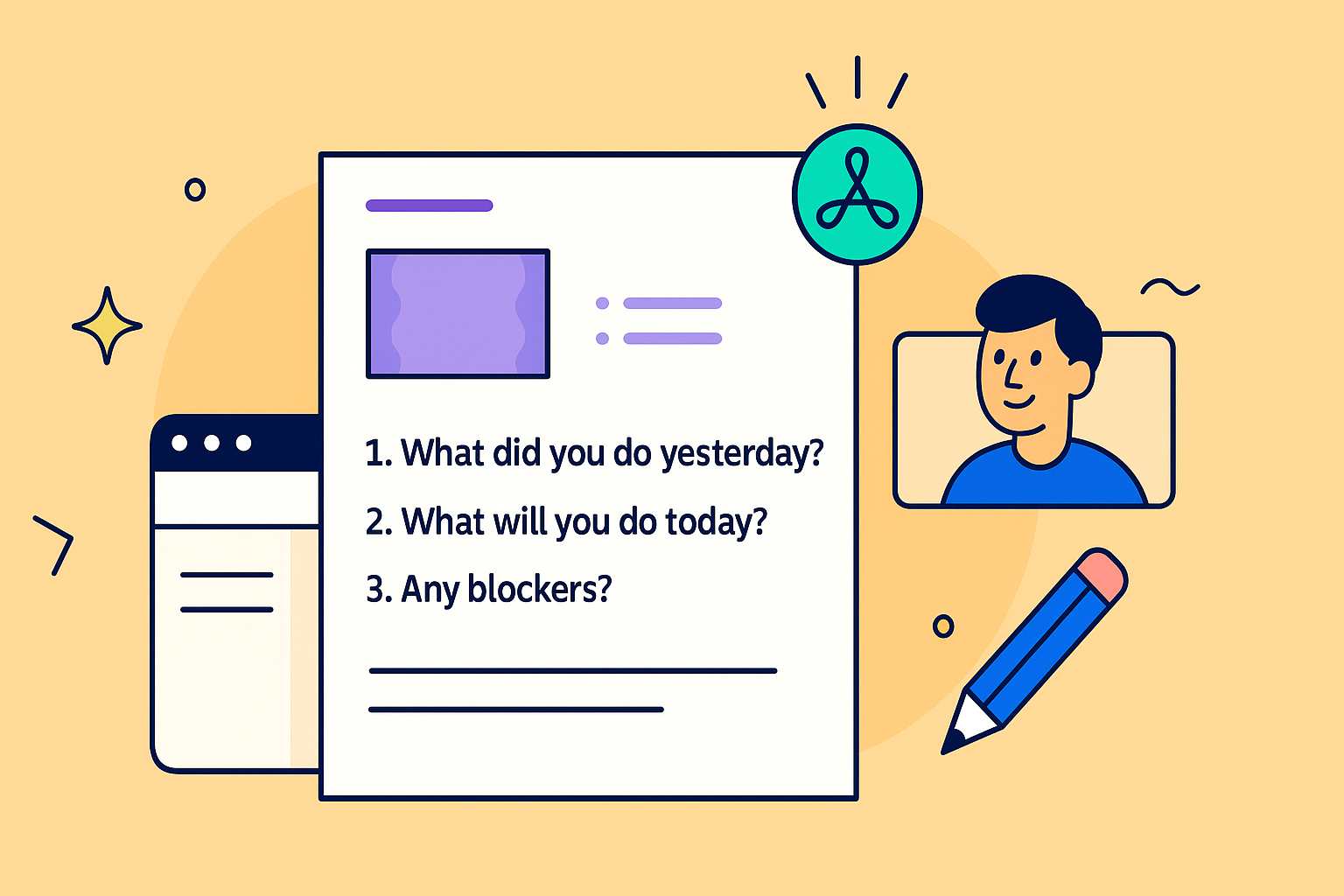The daily standup, or daily scrum, is a cornerstone of agile development, designed to align teams, surface impediments, and drive progress toward the sprint goal. However, many teams fall into a routine of answering the same three questions without real engagement, turning a vital ceremony into a monotonous status report. This rote repetition often fails to uncover hidden risks, foster collaboration, or inspire innovative problem-solving. To break this cycle, teams need to move beyond the basics and introduce a more dynamic set of scrum standup questions.
This guide provides a comprehensive list of high-impact questions organized by purpose, from tracking progress and identifying blockers to enhancing team health and focusing on the sprint goal. We’ll explore specific, actionable questions that provoke thought and create a more valuable, engaging daily sync. By varying your approach, you can transform your standup from a simple check-in to a powerful daily strategy session. To foster deeper insights and more meaningful dialogue in your standups, explore comprehensive 150+ open-ended questions examples that encourage detailed responses. These alternatives will help you uncover the nuanced information that traditional standup questions often miss, ultimately leading to a more effective and collaborative team environment.
1. What did you accomplish yesterday?
As one of the three foundational scrum standup questions, “What did you accomplish yesterday?” serves as a powerful mechanism for tracking progress and ensuring team-wide alignment. This question prompts each team member to articulate the specific, tangible work they completed since the last meeting. It’s not just about listing tasks; it’s about demonstrating forward movement toward the sprint goal, making it a cornerstone for accountability and transparency.

Popularized by Scrum creators Ken Schwaber and Jeff Sutherland, this question helps create a shared understanding of what has been achieved. It provides immediate visibility into the team’s velocity and each individual’s contribution, fostering a culture of ownership and consistent delivery.
How to Implement This Question Effectively
To get the most out of this question, encourage your team to move beyond simply stating activities. The focus should be on outcomes and their direct connection to the sprint objectives.
- Be Specific and Outcome-Oriented: Instead of “I worked on the user login feature,” a more effective response would be, “I completed the back-end validation for the user login form and merged the pull request, which moves story #123 to the ‘Done’ column.”
- Connect to Sprint Goals: Frame accomplishments in the context of the larger mission. For example, “I finished the API documentation, which unblocks the front-end team and gets us closer to our goal of launching the new integration.”
- Mention Collaboration: Highlighting teamwork reinforces a positive culture. A great answer might include, “Yesterday, Sarah and I pair-programmed to resolve a critical bug in the payment gateway.”
This structured approach transforms a simple status update into a meaningful progress report. For instance, teams at Microsoft Azure use this method to coordinate complex work across multiple development streams, ensuring everyone understands how individual efforts contribute to larger milestones. By keeping responses concise (under two minutes), the team maintains momentum without getting bogged down in unnecessary detail.
2. What will you work on today?
As the forward-looking counterpart to the first scrum standup question, “What will you work on today?” shifts the team’s focus from past accomplishments to future intentions. This question is critical for synchronizing daily activities, preventing redundant work, and identifying immediate opportunities for collaboration. It transforms the standup from a simple status report into a dynamic planning and coordination session, ensuring everyone is aligned on the day’s priorities.

Promoted by Scrum pioneers Ken Schwaber and Jeff Sutherland, this question is fundamental to maintaining sprint momentum. It creates a verbal commitment among team members and makes the day’s plan transparent, allowing the Scrum Master and Product Owner to see how the team is progressing toward the sprint goal in real-time.
How to Implement This Question Effectively
To maximize the value of this question, team members should articulate their plans with clarity and purpose, directly linking their tasks to the overall sprint objectives.
- Connect to Sprint Goals: Instead of saying, “I’ll be coding today,” a more impactful response is, “Today, I will build the checkout API endpoint, which is the final task for user story #245 and a key part of our sprint goal.”
- Identify Specific Deliverables: Clearly state what a successful day looks like. For example, “My goal today is to complete the user interface mockups for the new dashboard and share them for feedback by end of day.”
- Signal Collaboration Needs: Proactively mention dependencies. A great answer might be, “I plan to start integrating the payment service, so I’ll need to sync with Alex this morning to get the API keys.”
This approach helps teams coordinate complex work seamlessly. For instance, engineering teams at Google use this method to align daily tasks across large, interdependent feature releases, ensuring every developer understands their role in the day’s plan. Similarly, teams at Atlassian use it to coordinate development across products like Jira and Confluence, making sure individual plans contribute to a cohesive outcome.
3. What blockers or impediments are you facing?
As one of the three foundational scrum standup questions, “What blockers or impediments are you facing?” is the critical element that keeps the sprint moving forward. This question invites team members to identify any obstacle, dependency, or issue that is preventing them from making progress. It’s a proactive call for help that transforms individual struggles into team-wide problem-solving opportunities, empowering the Scrum Master to fulfill their primary role of removing impediments.

Popularized by Scrum pioneers Ken Schwaber and Jeff Sutherland and reinforced by thought leaders like Mike Cohn, this question is the engine of continuous flow. It ensures that problems are surfaced early and addressed collectively, preventing small issues from escalating into major delays. This transparency is key to maintaining a high team velocity and hitting sprint goals consistently.
How to Implement This Question Effectively
To maximize the value of this question, team members should be encouraged to be direct and specific about their blockers. The goal is to quickly identify the problem and the necessary next steps, not to solve it during the standup itself.
- Be Specific About the Blocker: Instead of saying, “I’m stuck on the API,” a more effective response is, “I’m blocked on story #456 because I need an API key from the infrastructure team and haven’t received it yet.”
- Suggest Potential Solutions: If possible, offer a path forward. For example, “I can’t proceed until the design is approved. Could the Product Owner review the mockups after this meeting?”
- Identify Who Can Help: Clearly state who or which team might be able to resolve the issue. This helps the Scrum Master direct their efforts efficiently.
- Follow Up Offline: The standup is for identification, not resolution. Plan to connect with the relevant people immediately after the meeting to work on a solution.
This focused approach creates a reliable system for overcoming hurdles. For instance, Tesla’s software teams use this question to quickly resolve cross-functional dependencies, ensuring their rapid innovation cycles are not disrupted. Similarly, Shopify uses it to coordinate work between platform and merchant-facing teams, preventing bottlenecks in their development pipeline. By integrating this query into your meeting cadence, you foster a culture where seeking help is encouraged and problems are solved swiftly.
4. How does your work contribute to the sprint goal?
This question elevates the daily standup from a simple status update to a strategic check-in. By asking “How does your work contribute to the sprint goal?”, teams are prompted to connect their daily tasks directly to the overarching objective of the sprint. It shifts the focus from “being busy” to “delivering value,” ensuring every action taken is purposeful and aligned with the team’s commitment.

Popularized by agile thought leaders like Roman Pichler and Jeff Patton, this question reinforces the “why” behind the work. It acts as a powerful course-correction mechanism, helping the team identify and eliminate tasks that do not contribute to the sprint goal, thereby preventing scope creep and wasted effort.
How to Implement This Question Effectively
To integrate this question successfully, foster an environment where team members feel safe to be transparent about their work’s alignment. The goal is to create focus, not to micromanage or judge individual tasks.
- Be Explicit About the Connection: Instead of saying, “I’m coding the new API endpoint,” a better answer is, “I’m finalizing the API endpoint, which is the last piece needed to complete the user profile story, our top priority for this sprint.”
- Encourage Honesty and Adaptation: If a task doesn’t directly support the sprint goal, it’s an opportunity for discussion. A team member might say, “I spent yesterday on a bug fix for a legacy module. It wasn’t planned, but it was critical. Does this impact our sprint goal?”
- Focus on Outcomes: Frame the contribution in terms of team success. For example, “I automated the deployment script, which helps us move closer to our sprint goal of reducing manual deployment time by 50%.”
This goal-oriented approach transforms the daily meeting into a forward-looking planning session. Companies like Airbnb use this principle to keep product teams tightly focused on user experience goals. By constantly validating their work against the sprint goal, they ensure that the team’s efforts remain centered on what matters most for the current iteration. This creates a clear feedback loop, which is vital for both the sprint review and retrospective.
5. What did you learn yesterday?
Shifting the focus from pure task completion to continuous improvement, “What did you learn yesterday?” is one of the most transformative scrum standup questions a team can adopt. It encourages team members to share insights, discoveries, and even failures, fostering a culture of psychological safety and collective growth. This question turns the daily standup into a micro-learning opportunity, capturing valuable knowledge that might otherwise be lost.
Popularized by agile pioneers like Kent Beck and Alistair Cockburn, this question helps teams working on complex problems or with new technologies to adapt and innovate faster. It moves beyond “doing” to “learning,” which is the true engine of agility. By making learning an explicit part of the daily routine, it accelerates skill development and prevents recurring mistakes.
How to Implement This Question Effectively
To maximize the impact of this question, guide your team to share concise yet actionable learnings that benefit everyone. The goal is to distribute knowledge, not to conduct a technical deep-dive.
- Share Both Technical and Process Learnings: Instead of just “I learned about a new API,” a better response is, “I learned that the v3 of the payment gateway API has a stricter rate limit, so we need to implement a caching strategy for future calls.” This also applies to process: “I learned our PR descriptions are too vague, which slows down code reviews.”
- Connect Learnings to Future Work: Frame insights in a forward-looking way. For example, “I discovered a new debugging technique in Chrome DevTools that will help us solve front-end bugs much faster on the upcoming user profile story.”
- Be Honest About Mistakes: A powerful learning can come from an error. Sharing it normalizes mistakes as growth opportunities. An effective answer could be, “I learned not to merge a database migration on a Friday afternoon after it caused a brief outage. We should update our deployment checklist.”
This approach turns individual discovery into team-wide capability. For instance, GitHub’s engineering teams use this practice to quickly disseminate new development techniques, while squads at Spotify use it to spread technical discoveries. These types of agile coaching questions are key to building a high-performing, resilient team. For more inspiration, you can learn more about agile coaching questions that drive continuous improvement.
6. Who do you need help from today?
Shifting focus from individual tasks to team interdependence, “Who do you need help from today?” is one of the most powerful scrum standup questions for fostering collaboration. It proactively identifies where support is needed, transforming the standup from a status report into a dynamic coordination session. This question prevents team members from getting stuck in isolation and encourages a culture where asking for help is seen as a strength, not a weakness.
This collaborative approach was championed by prominent Agile coaches like Tobias Mayer and Esther Derby. By explicitly asking who needs assistance, teams can quickly match needs with available expertise, remove blockers faster, and promote valuable knowledge sharing across the group. It directly tackles the common problem of team members struggling silently on a difficult task.
How to Implement This Question Effectively
To make this question a productive part of your daily standup, encourage team members to be clear and direct about their needs. The goal is to facilitate quick connections, not to solve the problem during the meeting itself.
- Be Specific About the Help Needed: Instead of saying, “I need help with the API,” a more effective request is, “I need 15 minutes with someone who understands our authentication library to review a potential security flaw.”
- Estimate the Time Commitment: Give your colleagues a sense of the required effort. For example, “I need about 30 minutes of pair programming with a front-end developer to debug a CSS issue.”
- Schedule Follow-Ups Immediately: The standup is for identification, not resolution. The immediate next step should be, “Okay, let’s sync up right after this meeting.”
This proactive approach to seeking and offering help is a cornerstone of efficient, small teams. For instance, Basecamp leverages this collaborative mindset to maintain high productivity with a lean structure. Similarly, distributed teams at Buffer use this to coordinate effectively across different time zones. By making help-seeking an explicit part of the daily routine, you can significantly improve team communication and accelerate progress toward the sprint goal.
7. What experiments are you trying today?
Moving beyond traditional status updates, “What experiments are you trying today?” injects a spirit of innovation and continuous improvement directly into the daily standup. This question shifts the team’s mindset from merely executing tasks to actively learning and adapting. It frames work as a series of small, testable hypotheses, encouraging a culture where discovery is as valued as delivery.
This approach, popularized by thought leaders like Eric Ries in “The Lean Startup” and Jeff Gothelf in “Lean UX,” is a cornerstone of agile methodologies. It encourages teams to challenge assumptions and find better ways to work or deliver value. This question transforms the daily scrum from a progress report into a forum for controlled, data-driven experimentation.
How to Implement This Question Effectively
To get the most out of this question, teams need to embrace a structured yet flexible approach to experimentation. The goal is to foster a safe-to-fail environment where insights are the primary currency.
- Frame Experiments as Hypotheses: Instead of “I’m going to try a new library,” a better approach is, “My hypothesis is that by using the new charting library, we can reduce page load time by 10%. I’ll test this today on the dashboard component.”
- Keep Experiments Small and Time-Boxed: Encourage quick, low-risk tests. For example, “I’m going to spend one hour today implementing a new caching strategy to see if it resolves the intermittent API latency.” This ensures experiments don’t derail sprint commitments.
- Share All Results, Including Failures: Learning what doesn’t work is just as valuable as learning what does. A team member might share, “My experiment to automate the build failed because of a compatibility issue, but I discovered a new plugin we can explore next.”
This method is used by innovative companies to drive incremental gains. For instance, engineering teams at Meta often use this experimental approach to test performance optimizations, while teams at Amazon apply it to continuously refine the customer experience. By making experimentation a daily habit, you build a resilient team that is always improving.
8. How confident are you about meeting our sprint commitment?
Moving beyond retrospective status updates, this forward-looking question gauges the team’s collective belief in their ability to achieve the sprint goal. “How confident are you about meeting our sprint commitment?” acts as an early warning system, transforming subjective feelings into actionable data. It uncovers hidden risks, anxieties, and dependencies that traditional scrum standup questions might miss, fostering proactive problem-solving.
This predictive approach, often used in frameworks like the Scaled Agile Framework (SAFe) for Program Increment planning, shifts the focus from what has been done to what can be realistically achieved. It empowers the team to have an honest conversation about their progress and make necessary adjustments before it’s too late, promoting a culture of shared responsibility and adaptive planning.
How to Implement This Question Effectively
To make this question a valuable part of your standup, you need a simple, blame-free system that encourages honest participation. The goal is to identify risks, not to single out individuals.
- Use a Simple Scale: Implement a quick confidence vote using a 1-to-5 scale (where 1 is low confidence and 5 is high) or a simple “high/medium/low” system. This makes it easy for everyone to share their assessment quickly.
- Focus on the ‘Why’: The number itself is just a starting point. The real value comes from discussing the factors influencing low scores. Ask, “What would it take to get your confidence from a 3 to a 4?”
- Track Trends, Not Just Snapshots: A single day of low confidence might not be an issue, but a consistent downward trend is a clear signal that the team needs to intervene. This data helps in identifying recurring patterns or systemic problems. For more ideas on boosting participation, explore these meeting engagement ideas.
This technique encourages psychological safety and collective ownership. For example, teams at ING Bank use confidence voting to assess their readiness for continuous delivery pipeline changes, while Spotify squads use similar indicators to make informed decisions about feature releases. By regularly asking this question, you can ensure the sprint commitment remains a realistic target, not just a hopeful wish.
Scrum Standup Questions Comparison Table
| Question | Implementation Complexity 🔄 | Resource Requirements ⚡ | Expected Outcomes 📊 | Ideal Use Cases 💡 | Key Advantages ⭐ |
|---|---|---|---|---|---|
| What did you accomplish yesterday? | Low – simple individual reporting | Low – requires only team participation | Visibility into progress, accountability, tracking sprint velocity | Teams needing daily accountability and visibility | Increases accountability, tracks progress, builds momentum |
| What will you work on today? | Medium – requires forward planning | Medium – coordination among team members | Improved alignment, prevents duplication, promotes collaboration | Teams coordinating daily priorities and sprint alignment | Enhances coordination, prevents wasted effort, fosters collaboration |
| What blockers or impediments are you facing? | Medium – requires facilitation | Medium – needs Scrum Master involvement | Rapid issue resolution, removal of obstacles | Teams facing cross-functional dependencies and stuck tasks | Enables fast problem-solving, maintains velocity, increases support |
| How does your work contribute to the sprint goal? | Medium – strategic focus needed | Low – individual reflection required | Maintains sprint focus, prevents scope creep | Teams emphasizing value delivery and goal alignment | Keeps focus on goals, prevents wasted work, improves sprint success |
| What did you learn yesterday? | Medium – requires reflection time | Low – individual sharing | Promotes learning, knowledge sharing, continuous improvement | Teams working on complex problems or new tech | Accelerates skill development, fosters innovation, shares insights |
| Who do you need help from today? | Medium – collaboration focus | Medium – requires open communication | Identifies support needs, prevents isolation | Teams relying on cross-skills and mentoring | Boosts collaboration, reduces silos, accelerates problem-solving |
| What experiments are you trying today? | High – encourages innovation mindset | Medium – time for experiments | Drives innovation, continuous improvement | Teams in uncertain environments or process improvement efforts | Fosters creativity, builds adaptive skills, supports data-driven decisions |
| How confident are you about meeting our sprint commitment? | Medium – predictive assessment | Low – sentiment polling | Early risk detection, informed scope adjustments | Teams needing risk management and early warning | Enables early course correction, improves planning, builds trust |
Final Thoughts
The daily standup is more than just a routine status update; it’s the heartbeat of an agile sprint. It’s a daily opportunity to sync, adapt, and reinforce the team’s shared commitment to a common goal. However, its effectiveness hinges entirely on the quality of the conversation, which is driven by the questions being asked. Moving beyond the traditional “yesterday, today, blockers” trio unlocks a deeper level of engagement, proactive problem-solving, and continuous improvement.
By integrating a diverse set of scrum standup questions, teams can transform this brief meeting from a monotonous ritual into a dynamic, strategic huddle. Questions focused on the sprint goal reinforce purpose, while those about learnings and confidence levels foster a culture of transparency and psychological safety. This shift turns the standup into a powerful mechanism for identifying risks early, celebrating small wins, and ensuring every team member feels supported and aligned.
Key Takeaways for Elevating Your Standup
The true power of these questions lies not in asking them all every day, but in using them strategically. Consider these core principles as you refine your approach:
- Vary Your Questions: Don’t let the standup become predictable. Rotate in questions about learning, confidence, or collaboration to keep the discussion fresh and insightful.
- Focus on Outcomes, Not Just Activity: Shift the conversation from “what I’m doing” to “how my work is advancing our sprint goal.” This keeps the team focused on delivering value.
- Make It a Conversation: The goal isn’t just to report status; it’s to facilitate communication. Encourage follow-up questions and peer-to-peer support directly within the meeting.
Your Actionable Next Steps
Mastering the art of the standup is an ongoing process. To start implementing these ideas, choose one or two new questions from this article to introduce in your next daily standup. Observe how your team responds and what kind of discussions emerge. For example, try asking, “How confident are you about meeting our sprint commitment?” at the midpoint of your sprint to gauge team morale and identify hidden risks.
Ultimately, the goal is to cultivate a standup environment where every voice is heard, impediments are surfaced without fear, and the team leaves feeling energized and aligned for the day ahead. The right scrum standup questions are your most powerful tool for building that culture, turning a simple 15-minute meeting into one of the most valuable investments your team makes each day. By being intentional with your questions, you empower your team to not just execute tasks, but to truly own the sprint outcome and drive collective success.
To further streamline your agile processes and centralize team knowledge, consider integrating powerful tools into your existing workflow. For enhanced collaboration and information management within your Atlassian ecosystem, explore the solutions offered by resolution Reichert Network Solutions GmbH. Their apps can help connect your teams and centralize the very information discussed in your daily standups.
